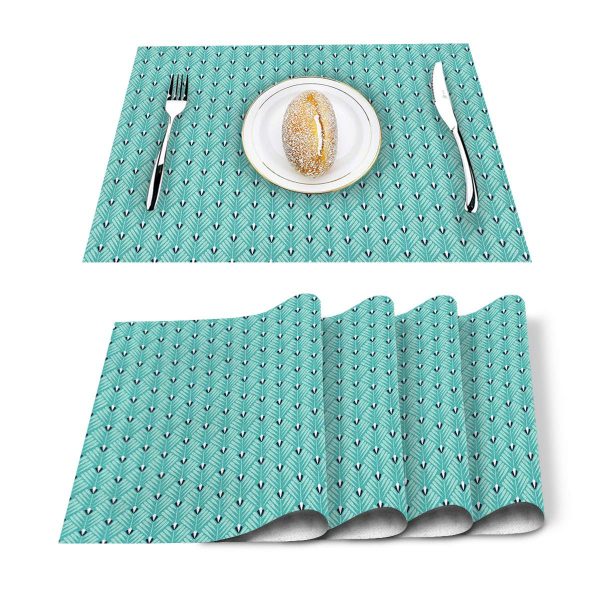
Are you considering making a quilted placemat? You'll be thrilled to know that you have a wealth of options! With so many shapes, sizes, and patterns available, you can customize your placemat to reflect your personal style. Common shapes include rectangles, squares, and rounds, but the possibilities don't end there. Plus, incorporating fusible interfacing and batting can add a delightful plush touch to your quilt.

Whether you're crafting placemats for yourself or as gifts for loved ones, there are a few factors to consider before diving in. Think about your table size and style; these will guide you in choosing the perfect shape and fabric. Rectangles are a great option, especially if you're a beginner. They efficiently protect your table and catch any food that might stray from your plate.
To craft a standard-sized rectangle placemat, you'll require two and a quarter yards of fabric. Simply use a sewing machine to sew one side with a straight stitch. Don't forget to leave a five-inch gap in the middle for easy turning of the corners.
You can explore various styles like quilted designs with decorative topstitching and batting, or double-sided mats needing about four and a half yards of fabric, allowing for flexibility in design.
If you're keen on exploring new trends in buildings, you might find our article on the Top 5 Greenest Buildings in the World quite inspiring.
How do you envision your dining table? Incorporating specific patterns or colors can enhance the dining experience, and round placemats offer elegance while guarding against spills and scratches.
Round is the most popular shape, but you can also find ovals and squares that blend function with style. If your table is small, a 12x16 inch placemat might suit it better. For larger tables, consider going with a 14 or 15-inch round design.
Using a mat with a non-slip backing, made from materials like polypropylene or cotton, ensures easy cleaning and added safety against spills, especially on new tables. Quilted options can offer extra insulation and come in delightful variations, including scalloped edges or internal batting.
Are you ready to dive into sewing? It's a fun, easy project—you'll need around 3 yards each for your exterior and lining fabric, plus binding material. Sketch your placemat's dimensions on wrapping paper to guarantee a perfect fit.
Square placemats, though less common, offer a chic minimalist touch. They compactly protect your dinner plates while offering flexibility. They’re ideal for creating a seamless look on both large and small tables.
These mats fold easily, perfect for transporting between tables while preserving your dining setup's aesthetics. Squares offer numerous production techniques; some choose to sew them the traditional way, while others use batting for a simple yet effective design board.
Using a quilting ruler helps achieve precise cuts, resulting in a clean and beautifully finished product after binding. If you're new to sewing, creating your own placemat may be easier than you think. With a few hours and the right tools, you can craft an item to cherish over the years.
Having a few extra placemats ready is always a good idea—they can save the day when unexpected guests arrive, expanding the elegance of your dining room.
Want your placemat to have that luxurious store-bought feel? Fusible interfacing can add perfect stiffness and structure. It comes in rolls, sheets, and even tapes in various weights, allowing customization according to your fabric's needs.
To use fusible interfacing, cut it to size as per the manufacturer's guidelines. This ensures no excess interferes at the seams. It's an easy method to create sturdy, machine-washable placemats.
When applying interfacing, protect your fabric from heat using a press cloth. For heavier fabrics, a little steam can help ease the glue on fusible interfacing, facilitating removal.
Ideally, the interfacing should be lighter than the main fabric, enhancing strength, maintaining shape, and warding off pesky wrinkles. Choose a woven, non-stretch variety for optimal results. HeatnBond Therm-O-Web is a reliable choice for projects like these.
When embarking on your placemat project, selecting the right batting is crucial. Options include cotton, which is durable and machine-friendly, and polyester, which also offers easy washability. Each choice depends on your intended quilt type.
For instance, wool provides excellent drape and is great for hand quilting, while bamboo is an eco-friendly pick perfect for summer quilts. Additionally, you can opt for cotton/poly blends for affordability without sacrificing quality.
Fusible cotton batting offers ease of use by keeping layers in place using heat or a glue-like substance.
If planning on reversible placemats, select a batting that allows easy turning of your project, making sure to tuck seam allowances discreetly.
You can purchase patterns with pre-cut batting, which is especially helpful for beginners. This simplifies quilting and fleece interfacing steps.
For a more visual guide, check out this instructional video below.
Whether you're just starting or are experienced in sewing, constructing your own quilted placemats is a rewarding project that brings warmth to your table and cheer to your gatherings!